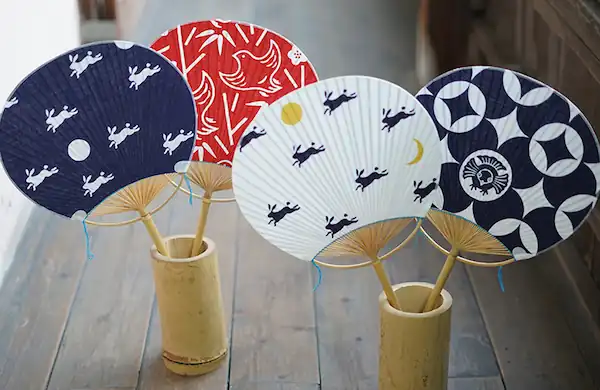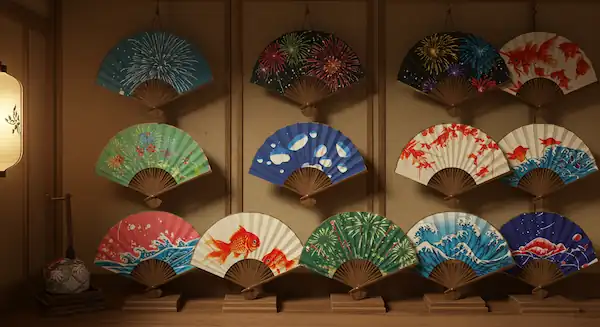Sensu (Folding Fans) and Uchiwa (Flat Fans) – Their History and Stylish Use
Long before air conditioning became commonplace, the Japanese people found ingenious and aesthetically pleasing ways to stay cool during the country’s notoriously humid summers.
Two prime examples are the sensu (folding fan) and the uchiwa (flat fan).
Far from being mere tools to combat the heat, these items deeply reflect Japanese culture, history, and aesthetic sensibilities.
Table of Contents
While they may appear similar at first glance, the sensu and uchiwa actually have vastly different origins, histories, and uses.
This article will delve into the profound world of each, exploring their charms and how they are elegantly used.
Uchiwa: A Beloved Summer Tradition for the Common People

History and Origins: From China to Japan, and into Daily Life
The origins of the uchiwa are incredibly ancient, tracing back to China’s Zhou Dynasty (3rd century BCE).
Flat fans are also depicted on the tomb walls of Ramesses II in ancient Egypt from the same period, suggesting they spread from China to Egypt.
Initially called “sashiba” (翳), they were used not only for cooling but also during rituals for aristocrats and women to conceal their faces, or as ceremonial tools to ward off insects, evil spirits, and misfortune.
The presence of figures holding uchiwa in the wall paintings of the Asuka-era Takamatsuzuka Tomb further indicates their early arrival in Japan.
After being introduced to Japan, uchiwa gradually developed.
During the Nara and Heian periods, elaborate and large fans were made for the aristocracy, while lighter, easier-to-use uchiwa began to be used among commoners.
By the late Muromachi period, the basic structure of today’s uchiwa – bamboo ribs covered with paper – was established, evolving into a more accessible and practical tool.
In the Edo period, uchiwa became widely integrated into common people’s lives. Beyond providing coolness, they became indispensable for various daily tasks, such as fanning charcoal fires for cooking or cooling down food.
The development of woodblock printing technology greatly contributed to this widespread adoption.
The mass production of uchiwa-e (fan prints) became possible, and with ukiyo-e (woodblock prints) and actor portraits depicted on them, uchiwa transcended mere utility, serving as a medium to convey the trends and culture of the time.
In this way, uchiwa transformed from a symbol of aristocracy to an integral part of common life, and even an advertising medium, firmly establishing itself as a quintessential summer feature in Japan.
For Casual Summer Attire: Yukata, Summer Festivals, and Bon Odori
Today, uchiwa are firmly established as a summer staple, casually used with yukata (light summer kimonos) at events like summer festivals and Bon Odori (traditional dance festivals).
The abundant breeze generated by their large surface brings both coolness and vibrancy to lively summer gatherings.
An uchiwa’s strong airflow is perfect for quickly cooling down on a humid summer festival night.
Furthermore, their flat, wide surface is ideal for printing festival or event logos and characters, making them popular as novelty items or cheering goods (merchandise).
Thus, the physical characteristics of uchiwa have solidified their cultural role in Japan’s bustling outdoor summer events.
Beyond providing coolness, their practicality in daily life, such as fanning charcoal fires or cooling food, remains relevant.
Due to their convenience and functionality, uchiwa continue to be an essential summer item, unchanged from past to present, intertwined with the lives of Japanese people.
The Charm of Japan’s Three Great Uchiwa: Traditional Crafts Rooted in Region
Japan boasts “Japan’s Three Great Uchiwa,” traditional crafts deeply rooted in specific regions.
These reflect the local climate, history, and possess unique manufacturing methods and aesthetics.
The distinct structure and materials of each fan are a testament to the technology and aesthetic sense fostered in that region.
- Kyō-uchiwa (Kyoto Uchiwa)
Also known as “Miyako-uchiwa,” these are elegant craft items used even in the imperial court.
Originating from Korean fans, they were introduced to Kyoto during the Northern and Southern Dynasties period.
The most distinctive feature of Kyō-uchiwa is their “sashie” (差し柄) structure, where the fan ribs and handle are made separately and then the handle is inserted.
Kyoto’s finest materials, such as 4-5 year old bamboo from Saga, are meticulously selected, and the handles are often adorned with lacquer or gold leaf, making them the pinnacle of sculptural craftsmanship, with their advanced techniques passed down to this day.
The more ribs a fan has, the more luxurious it is considered.
While uchiwa are generally seen as casual tools, Kyō-uchiwa stand out as special objects with artistic value. - Marugame-uchiwa (Marugame Uchiwa)
Produced around Marugame in Kagawa Prefecture, these are also called “Sanuki-uchiwa.”
Conceived in the early Edo period as souvenirs for pilgrims visiting Kotohira-gū Shrine, uchiwa production flourished as a major regional industry when the Marugame domain encouraged it as an inner craft for samurai.
A characteristic of Marugame-uchiwa is that the handle and ribs are made from a single piece of bamboo (flat handle, round handle).
It is said that about 90% of all uchiwa in Japan are produced in Marugame, making it the top producer of these traditional crafts. - Bōshū-uchiwa (Boshu Uchiwa)
Made in the southern part of the Bōsō Peninsula in Chiba Prefecture.
The abundance of quality bamboo in this region contributed to the development of Bōshū-uchiwa.
Their distinctive features include the “maru-e” (丸柄) or round handle, which utilizes the natural curvature of the bamboo, and the beautiful semicircular, lattice-patterned “mado” (窓) or “window” created by intricately splitting the bamboo ribs into 48-64 sections and weaving them with thread.
Supple bamboo harvested around Tateyama in Chiba is considered most suitable for Bōshū-uchiwa ribs, highlighting the attention to material selection.
The existence of these “Japan’s Three Great Uchiwa” demonstrates how the uchiwa, as a tool, has evolved uniquely, deeply intertwined with each region’s climate, history, and available resources.
The manufacturing methods and aesthetic sensibilities of each region imbue their respective uchiwa with individuality and cultural depth, symbolizing the richness of Japan’s diverse traditional crafts.
Sensu: Traditional Beauty Adorned with Elegance and Formality

Japanese Innovation: The Birth of the Folding Fan
The sensu originated later than the uchiwa, conceived in Japan, particularly Kyoto, around the mid-Heian period (9th century).
Initially, “hi-ōgi” (桧扇), made by binding thin wooden plates together (as paper was precious), were used primarily for recording.
Later, the “kami-ōgi” (紙扇), made from bamboo and paper, was born, and its groundbreaking foldable structure dramatically increased portability.
This innovative Japanese design was exported to China around the 13th century and then traveled along the Silk Road to Europe.
In Europe, lavish fans made of ivory, tortoiseshell, silk, and peacock feathers became wildly popular, and later, Western-style fans were re-imported to Japan as “kinu-ōgi” (絹扇), showcasing a history of international cultural exchange.
Thus, the birth and spread of the sensu vividly illustrate how Japan not only adopted foreign cultures but also generated its own cultural innovations, influencing the world.
In ancient times, they were called “ōgi” (扇) and, besides cooling, were used as props in Shinto rituals, ceremonies, tea ceremonies, dance, and other performing arts, and even as symbols of authority for rulers.
From its inception, the sensu took on multifaceted roles beyond simply a tool for sending air, expressing communication, status, and aesthetic sensibility.
Dignity in Formal Settings: The Beautiful Harmony of Kimono and Sensu
Due to its elegant appearance, the sensu is highly regarded as a etiquette item for formal occasions and when wearing traditional Japanese attire.
In the Japanese imperial family, female members of the imperial family continue to hold a folded sensu during ceremonies and events, even when wearing Western clothing, a cultural practice passed down from the Heian period.
This signifies that it is not merely an ornament, but a non-verbal tool for showing respect and humility, emphasizing its significance.
For the general public, carrying a sensu in formal settings, whether with a kimono or even Western clothes, is considered “adult etiquette” and conveys a refined and charming impression.
For auspicious occasions like weddings, a “shūgisen” (祝儀扇) or celebratory fan is used.
Its fan-like, spreading shape is considered auspicious, and it typically has black lacquered outer ribs and gold or silver fan leaves.
The act of carrying a sensu itself elevates the dignity of the occasion, embodying traditional Japanese aesthetics and etiquette.
Sensu as a Craft: The Profound World of Kyō-sensu
Sensu have been treated as works of craft art since ancient times due to their beauty and intricate craftsmanship.
Kyō-sensu (Kyoto Folding Fans) are a prime example.
Kyō-sensu boast a history of over 1000 years, originating in Kyoto in the early Heian period and developing deeply rooted in the daily lives of the imperial court society.
Today, to be called a “Kyō-sensu,” a fan must meet strict criteria: it must be made by a member of the Kyoto Sensu & Uchiwa Industry Cooperative, using materials produced primarily in Kyoto and within Japan.
This rigorous regulation indicates that “Kyō-sensu” is not merely a regional name but a brand guaranteeing the highest quality and traditional craftsmanship.
The reason Kyō-sensu are expensive lies in their manufacturing process and meticulous attention to materials.
Their elegant and refined beauty is born from the combination of skilled craftsmanship and high-quality raw materials.
Premium madake bamboo from the Kyoto Tanba region is used, and the production of the fan ribs requires delicate techniques, such as steaming the bamboo and splitting it with hammers and specialized knives.
Furthermore, the manufacturing process is divided into 87 steps, each handled by a specialized artisan in a “division of labor” system.
This “relay” of artisans results in more durable and delicate Kyō-sensu.
They also feature functional beauty: a higher number of ribs than other sensu and a narrower fold width allow for very smooth opening and closing, and a beautiful compact shape when closed.
This fusion of exceptional functionality and beauty constitutes the high value of Kyō-sensu.
“Shishū-sen” (刺繍扇), or embroidered fans, made of silk with delicate embroidery, are particularly suitable as gifts and are said to pair well with Western attire.
Here are some examples of high-priced Kyō-sensu, products that encapsulate artistry and craftsmanship:
| Product Name | Features/Use | Price Range (Tax Incl.) |
| High-Grade Decorative Kyō-sensu: Hand-painted Dragon / With Stand | Decorative fan, hand-painted, with stand | ¥35,200 |
| [Black-dyed Ribs] Decorative Kyō-sensu: High-Grade Shimai-sensu Moon & Autumn Grass / Cherry Blossom | Decorative fan, Shimai-sensu for dance, black-dyed ribs | ¥33,000 |
| Decorative Kyō-sensu: High-Grade Shimai-sensu Flower Cart / Autumn Leaves | Decorative fan, Shimai-sensu for dance | ¥33,000 |
| High-Grade Decorative Kyō-sensu: Goldfish / With Stand | Decorative fan, with stand | ¥23,100 |
| High-Grade Decorative Kyō-sensu: Sōtatsu Wind God Painting / With Stand | Decorative fan, with stand | ¥18,370 |
| WDH Kyō-sensu | Modern Japanese design, unisex 7-inch size, ideal for gifts | ¥11,000~ (Excl. Tax) |
| Women’s Set Sensu: Hagi (Bush Clover) with Fan Pouch / Hand-painted Kyō-sensu | Women’s, hand-painted, with fan pouch | ¥12,980 |
Sensu and Uchiwa: The Art of Smart Usage and Elegant Selection

Airflow vs. Portability: Smart Choices Based on the Scene
The most significant functional differences between sensu and uchiwa lie in the amount of airflow they generate and their portability.
Uchiwa produce a stronger breeze than sensu, making them suitable when you want significant cooling on a hot summer day, or for practical uses like fanning charcoal fires or cooling food.
Their wide surface excels at moving a large volume of air at once.
Sensu, on the other hand, with their foldable structure, are incredibly convenient when you have limited bag space or want to go hands-free.
Even small uchiwa can be difficult to fit in a pocket or neatly store in a bag.
This difference in portability is a major factor determining the situations in which each tool is used.
Furthermore, because uchiwa have a flat, easily printable surface, they serve as an advertising medium for company or event promotions, novelty items, promotional goods, and idol cheering merchandise.
Sensu, with their uneven surface, are less suitable for large-area printing.
Thus, the physical shape and function of each tool have shaped the roles they play in society and culture.
Choosing the Right Fan for Your Attire: Yukata vs. Kimono
The distinction between using an uchiwa and a sensu is not merely about functionality; it also deeply involves “manners” and “aesthetics” that enhance the elegance of Japanese summer attire.
For the casual and light yukata, the unpretentious coolness of an uchiwa is a perfect match.
At summer festivals and fireworks displays, the combination of yukata and uchiwa is a classic style, naturally blending into the festive atmosphere.
Conversely, the elegance and formality of a kimono harmonize beautifully with the graceful gestures of a sensu.
Especially in formal settings, holding a sensu adds dignity to the overall attire.
The gestures of quietly opening and closing a sensu, or holding it folded, are expressions of traditional Japanese aesthetics and politeness, further enhancing the ambiance of the occasion.
In this way, sensu and uchiwa are profound tools that enrich the Japanese summer style by being chosen appropriately for each attire and situation.
A Cool Summer with Eco-Friendly Sensu and Uchiwa: A Sustainable Choice
Environmentally Conscious Materials and Brand Initiatives
Traditional sensu and uchiwa primarily use natural materials like bamboo, washi (Japanese paper), and hemp, making them inherently sustainable choices. These materials are renewable, produced under properly managed conditions, and ultimately return to the earth. This characteristic resonates deeply with contemporary environmental awareness, allowing us to recognize the inherent sustainability of traditional craftsmanship.
In recent years, new materials and manufacturing methods have been developed to further reduce environmental impact. For example, uchiwa made from “LIMEX,” a new Japanese material primarily composed of limestone, can serve as an alternative to paper and plastic, and is highly recyclable after use. Additionally, “dioxin-suppressing uchiwa” have emerged, with special iron oxide compounded into the rib sections, expected to reduce dioxin generation during incineration. Shiratakedo, a long-established Kyō-sensu manufacturer in Kyoto, positions sensu as low-environmental-impact, ethical items, offering sustainable products like the “Airbag Kyō-sensu.”
Brands like Nakagawa Masashichi Shoten, operating under the philosophy of “making things while listening to the voice of materials,” prioritize crafting products that leverage the characteristics of materials nurtured by Japan’s climate. Their uchiwa and sensu use natural materials like hemp, washi, and bamboo, excelling in absorbency and quick-drying properties, and by lasting longer, they ultimately reduce environmental impact—showcasing an approach that fuses traditional wisdom with modern sustainability. Long-established businesses like Ibasen (founded in 1590) also achieve both tradition and sustainability by using carefully selected domestic bamboo, washi, and fibers, handcrafted by skilled artisans. These brands’ initiatives demonstrate a deeper commitment to sustainability, not just through using eco-materials, but by preserving cultural heritage and caring for the environment through regional craftsmanship and high-quality, long-lasting products.
How to Purchase in Your Area: Tips for Buying
To acquire eco-friendly sensu or uchiwa, or traditional masterpieces, you can visit specialty stores, department stores, or online shops. Especially in stores that handle traditional crafts, you can learn about the artisans’ dedication and the product’s background. Below are some eco-friendly sensu/uchiwa brands and key places to purchase them, particularly in Osaka.
| Brand Name | Eco-Friendly/Traditional Craft Features | Main Purchase Locations in Osaka | Notes |
| Nakagawa Masashichi Shoten | Focuses on meticulous craftsmanship using the textures of natural materials (hemp, washi, bamboo). Emphasizes collaboration with regional artisans to provide long-lasting products. | Kintetsu Abeno Harukas, Hanshin Umeda Main Store, Bunkaten Tabi Osaka International Airport, Lucua 1100, Namba Parks. | While explicit “eco” labeling is limited, its philosophy and material selection contribute to sustainability. |
| Ibasen | Long-established since 1590. Uses carefully selected domestic bamboo, washi, and fibers, handcrafted by skilled artisans. Emphasizes the continuation of Edo culture. | (Head office in Tokyo Nihonbashi) Available for purchase online. | Traditional materials and craftsmanship themselves contribute to the product’s durability and sustainability. |
| Tanseido | Long-established since the Edo period. Handles washi decorative items, sensu, and uchiwa. “Mizu-uchiwa” (water fan), a rare item moistened with water for cooling, offers an environmentally conscious way to stay cool. | Tanseido Sōten (1-6-12 Namba, Chuo-ku, Osaka). | “Mizu-uchiwa” merges Japanese aesthetics with eco-friendly usage. |
| Shiratakedo | Kyoto’s long-established Kyō-sensu manufacturer founded in 1718. Positions sensu as low-environmental-impact, ethical items, and offers sustainable products like “Airbag Kyō-sensu.” | (Main store in Kyoto) Available for purchase on their official online shop. | A brand that actively promotes its ethical initiatives. |
| Sai Art | Manufactures and wholesales original products, including Danjiri goods and Danjiri sensu. | 7-1 Abiko, Izumiotsu City, Osaka Prefecture. | For detailed information on eco-friendly sensu/uchiwa, direct inquiry is recommended. |
Conclusion: Embrace Japanese Tradition for a Cool Summer
Sensu and uchiwa are more than just tools to beat Japan’s summer heat.
Their history is deeply intertwined with the evolution of Japanese culture, with each fostering distinct roles and aesthetics.
The uchiwa, a casual presence, accompanies common people’s lives, coloring summer festivals and everyday scenes.
The sensu, imbued with elegance and formality, serves as a craft item demonstrating dignity in formal settings.
These are truly “palm-sized art,” condensing Japanese aesthetic sensibilities and wisdom.
Even in modern times, these traditional tools offer an eco-friendly and sustainable way to spend summer, without over-relying on air conditioning. In addition to the inherent sustainability of traditional materials and craftsmanship, by incorporating new eco-materials and manufacturing methods, sensu and uchiwa also contribute to an environmentally conscious lifestyle for the future.
If you can purchase one in your area, please consider using an eco-friendly sensu or uchiwa to get through the summer.
And as you feel the coolness they bring, and the profound depth of traditional Japanese culture, we hope you enjoy a rich and fulfilling summer.
References
- Aiba: The history of Kyoto fans
- Ibasen: The history of uchiwa | The evolution of its use and Japan’s three major uchiwa
- WA-MARE: The charm of elegant Kyoto fans, beloved by Heian aristocrats










Leave a Reply